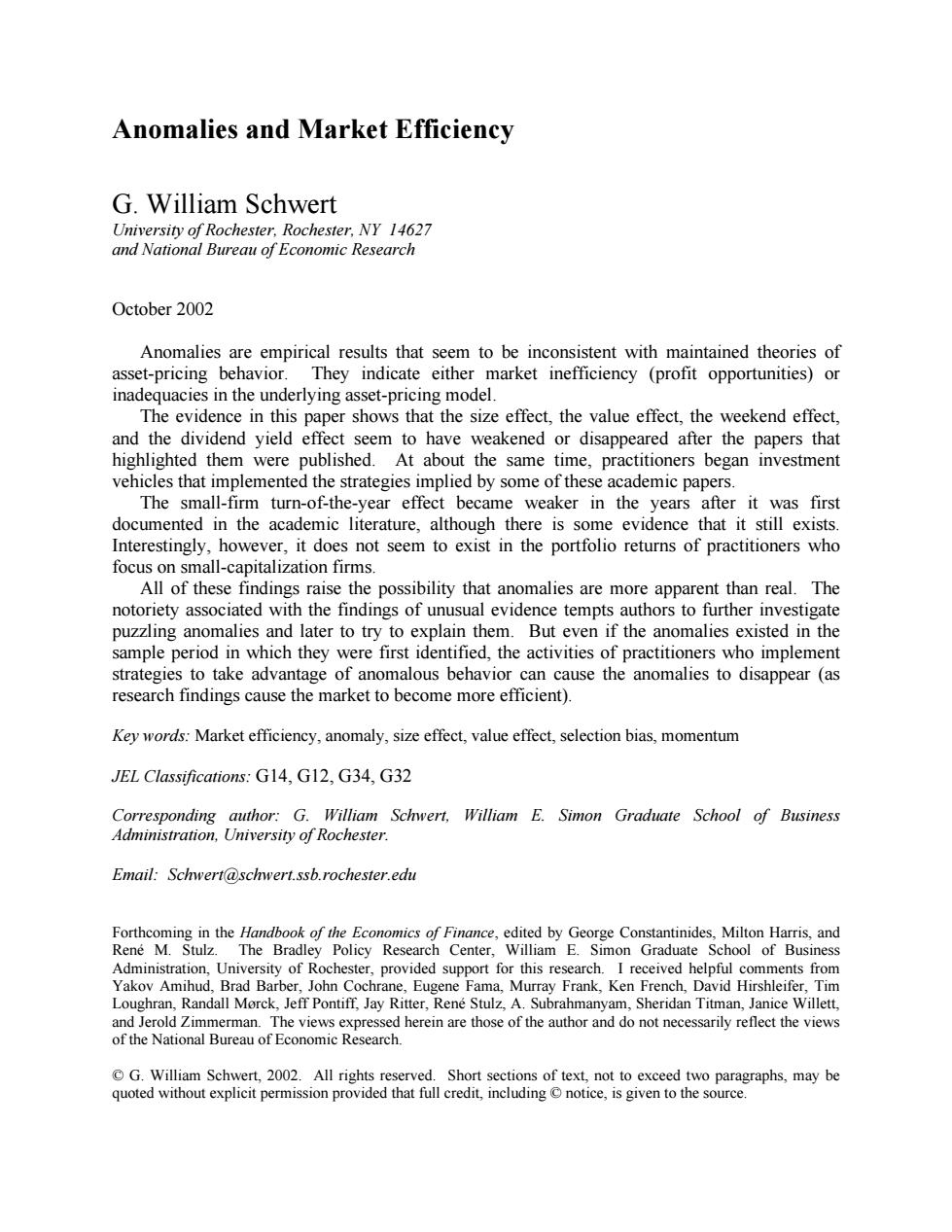正在加载图片...

Anomalies and Market Efficiency G.William Schwert University of Rochester,Rochester,NY 14627 and National Bureau of Economic Research October 2002 Anomalies are empirical results that seem to be inconsistent with maintained theories of asset-pricing behavior.They indicate either market inefficiency (profit opportunities)or inadequacies in the underlying asset-pricing model. The evidence in this paper shows that the size effect,the value effect,the weekend effect, and the dividend yield effect seem to have weakened or disappeared after the papers that highlighted them were published.At about the same time,practitioners began investment vehicles that implemented the strategies implied by some of these academic papers. The small-firm turn-of-the-year effect became weaker in the years after it was first documented in the academic literature,although there is some evidence that it still exists. Interestingly,however,it does not seem to exist in the portfolio returns of practitioners who focus on small-capitalization firms. All of these findings raise the possibility that anomalies are more apparent than real.The notoriety associated with the findings of unusual evidence tempts authors to further investigate puzzling anomalies and later to try to explain them.But even if the anomalies existed in the sample period in which they were first identified,the activities of practitioners who implement strategies to take advantage of anomalous behavior can cause the anomalies to disappear (as research findings cause the market to become more efficient). Key words:Market efficiency,anomaly,size effect,value effect,selection bias,momentum JEL Classifications:G14,G12.G34.G32 Corresponding author:G.William Schwert,William E.Simon Graduate School of Business Administration,University of Rochester. Email:Schwert@schwert.ssb.rochester.edu Forthcoming in the Handbook of the Economics of Finance,edited by George Constantinides,Milton Harris,and Rene M.Stulz.The Bradley Policy Research Center,William E.Simon Graduate School of Business Administration,University of Rochester,provided support for this research.I received helpful comments from Yakov Amihud,Brad Barber,John Cochrane,Eugene Fama,Murray Frank,Ken French,David Hirshleifer,Tim Loughran,Randall Morck,Jeff Pontiff,Jay Ritter,Rene Stulz,A.Subrahmanyam,Sheridan Titman,Janice Willett, and Jerold Zimmerman.The views expressed herein are those of the author and do not necessarily reflect the views of the National Bureau of Economic Research. G.William Schwert,2002.All rights reserved.Short sections of text,not to exceed two paragraphs,may be quoted without explicit permission provided that full credit,including notice,is given to the source.Anomalies and Market Efficiency G. William Schwert University of Rochester, Rochester, NY 14627 and National Bureau of Economic Research October 2002 Anomalies are empirical results that seem to be inconsistent with maintained theories of asset-pricing behavior. They indicate either market inefficiency (profit opportunities) or inadequacies in the underlying asset-pricing model. The evidence in this paper shows that the size effect, the value effect, the weekend effect, and the dividend yield effect seem to have weakened or disappeared after the papers that highlighted them were published. At about the same time, practitioners began investment vehicles that implemented the strategies implied by some of these academic papers. The small-firm turn-of-the-year effect became weaker in the years after it was first documented in the academic literature, although there is some evidence that it still exists. Interestingly, however, it does not seem to exist in the portfolio returns of practitioners who focus on small-capitalization firms. All of these findings raise the possibility that anomalies are more apparent than real. The notoriety associated with the findings of unusual evidence tempts authors to further investigate puzzling anomalies and later to try to explain them. But even if the anomalies existed in the sample period in which they were first identified, the activities of practitioners who implement strategies to take advantage of anomalous behavior can cause the anomalies to disappear (as research findings cause the market to become more efficient). Key words: Market efficiency, anomaly, size effect, value effect, selection bias, momentum JEL Classifications: G14, G12, G34, G32 Corresponding author: G. William Schwert, William E. Simon Graduate School of Business Administration, University of Rochester. Email: Schwert@schwert.ssb.rochester.edu Forthcoming in the Handbook of the Economics of Finance, edited by George Constantinides, Milton Harris, and René M. Stulz. The Bradley Policy Research Center, William E. Simon Graduate School of Business Administration, University of Rochester, provided support for this research. I received helpful comments from Yakov Amihud, Brad Barber, John Cochrane, Eugene Fama, Murray Frank, Ken French, David Hirshleifer, Tim Loughran, Randall Mørck, Jeff Pontiff, Jay Ritter, René Stulz, A. Subrahmanyam, Sheridan Titman, Janice Willett, and Jerold Zimmerman. The views expressed herein are those of the author and do not necessarily reflect the views of the National Bureau of Economic Research. © G. William Schwert, 2002. All rights reserved. Short sections of text, not to exceed two paragraphs, may be quoted without explicit permission provided that full credit, including © notice, is given to the source